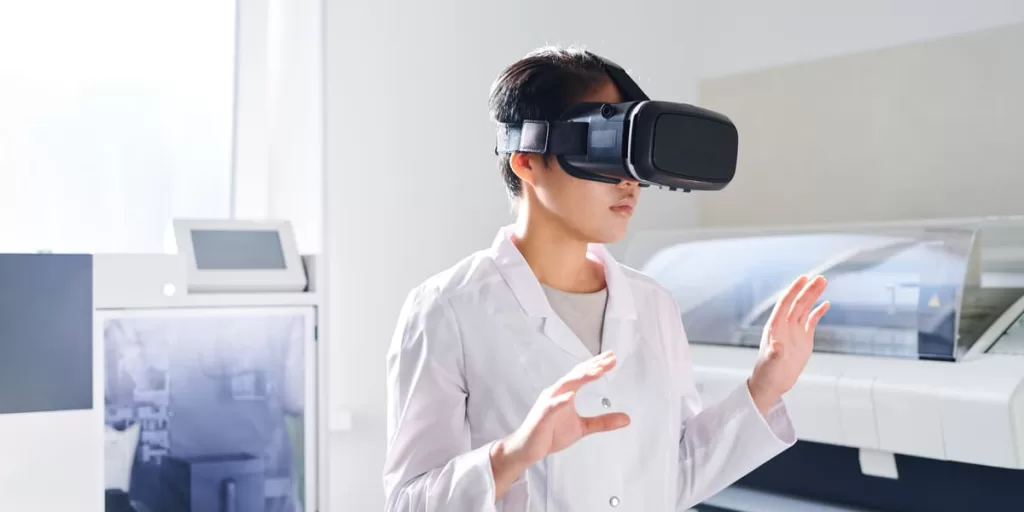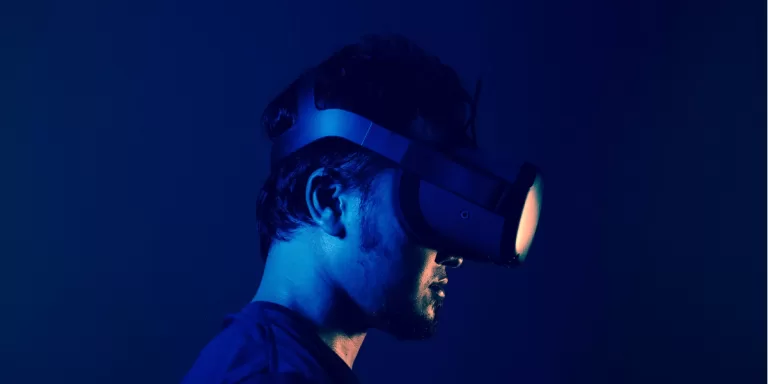It has been a little over a decade since modern virtual reality devices began to be marketed. Although at first, their inclusion was slow, in recent years most industries have realized the enormous potential of including them in their area and leaving the exclusive use of immersive reality to the entertainment industry would have been a big mistake, because for the industrial, medical, aerospace, among others, this technology involves great advantages.
What is Virtual Reality or VR?
Virtual Reality or Virtual Reality (VR) is a simulated environment processed by software and hardware, which allows the user to be immersed in a digital environment that may or may not, depending on the intention, have a realistic appearance.
This immersion is achieved thanks to the implementation of different devices that place the user’s senses within an artificial environment. The senses of sight and hearing are the ones that are exploited to a greater extent thanks to the use of a Virtual Reality viewer and headphones with 360° sound.

Because of its resemblance, it is very common to confuse virtual reality with augmented reality.
Difference between virtual reality and augmented reality?
Due to their characteristics and environment, it is very common to confuse these two concepts. The difference between VR and AR lies in their integration with physical reality; augmented reality adds or prints objects in physical reality by making use of cameras or screens, while virtual reality offers a 100% digital environment, creating a totally fictitious scenario.
The easiest augmented reality example to land on is Instagram or Snapchat filters, where users can modify their faces and environments on their screens thanks to mapping. Another popular AR app is Pokemon Go, where users have the possibility to “hunt” pokemon in the real world thanks to their smartphones.
Thanks to the constraint of being strictly linked with physical reality it is easy to distinguish the difference between these two types of technologies.
How does virtual reality work?
Virtual reality can be classified into 3 types of operation: immersive, non–immersive, and semi–immersive.
Immersive VR or VR 360 simulates a three–dimensional environment where all viewing angles are covered by the simulation, sometimes the user has the opportunity to move within the environment and manipulate it thanks to gadgets.
Non–immersive is possible thanks to the use of a monitor, in this mode, we use the keyboard, mouse, or joystick controls to manipulate the environment. It is the most common model in video games.
What devices does Virtual Reality require?
There are several methods to access content made in VR format, the most common are virtual reality helmets or virtual reality glasses.
These peripherals are also known as HMD (Head Mounted Display) and are characterized by having an integrated screen. Among the most famous devices of this type are the Oculus Rift, Playstation VR, HoloLens, HTC Vive y Vive Pro, Star VR, Primax 4K and 8K among others.
Thanks to the accessibility to mobile devices have also standardized the use of VR cases, which allow the use of any smartphone with motion sensors. Among the best-sellers are Google’s Gear, Daydream View, and Cardboard, although these housings are now discontinued.
In what fields can Virtual Reality be used?

The popularization of VR systems can be attributed to the entertainment industry, particularly the video game industry, however, little by little different industrial sectors have opened up to the implementation of immersive technologies to improve processes or test new alternatives.
Industry
For different industries, the inclusion of virtual reality and augmented reality technologies have been beneficial at different levels of their organization. From personnel training, reducing processes that used to take up to two days to a couple of hours, to the presentation of products or production models to their customers.
Education
This is one of the broadest fields for immersive technologies, they can cover practically all educational levels, from preschool to university postgraduates.
“The premise is as simple as it is didactically perfect: to learn in interactive environments that seem real, where mistakes can be made without suffering the consequences and that manage to enhance the effectiveness of learning”
– El País
Some of the areas of knowledge that have sought support in virtual reality are various engineering, architecture, medicine, neuroscience, various health sciences, art, and even psychology.
There are many advantages offered by the link between VR and learning, such as the increase in the capacity of apprehension or the ability to immerse students in realistic environments to maximize the learning experience without the fear of making mistakes.
Medicine
As we have seen in the previous section, health sciences have been one of the areas that have benefited the most from technologies. Medical students can experience surgery without the need to enter a real operating room or put someone else’s life at risk.
Psychology
Virtual reality has also made it possible to create new alternatives for the treatment of eating disorders or phobias such as aerophobia, social phobia, or agoraphobia.
Entertainment
This has been one of the most explored fields as several companies, usually focused on cinema, have ventured into virtual reality intending to give new experiences to their consumers.
This segment achieves a perfect balance between cinematic knowledge, storytelling, and technology.
Companies such as Netflix have used the 360 experience to offer more content for their popular series such as Stranger Things or in the case of Google with Spotlight Stories awarded for its narrative resources.
Another outstanding case was Isle Of Dogs, a film directed by Wes Anderson where he broke with the traditional idea of behind the scenes, transporting us directly to the production area of the stop motion film.
Currently, systems such as Oculos already allow you to watch movies in Virtual Reality.
The music industry has also integrated this technology into its dynamics, thanks to the combination with 8D audio artists can see new market opportunities such as concerts in virtual reality.
Video games
The inclusion of VR technology in the video game industry was a radical change in the approach of developers and perhaps the area where more innovation has been generated due to the features where players often can explore the environment and feedback failures.
There are a lot of success stories of virtual reality games such as Star Wars: Squadrons or Microsoft Flight Simulator, No Man’s Sky, The Elder Scrolls V: Skyrim VR, or Beat Saber.
Tourism
The ability to discover the wonders of the world from the living room of our home is already a fact. Tourism companies have digitized physical places such as cities, resorts, and even cruise ships to give their potential customers an innovative experience before they dare to travel.
Military industry
The military industry has never been oblivious to technological advances, in fact, in most cases the technologies that we enjoy daily are born from the search for better defense systems. For the military industry, the integration of VR helps soldiers to have a more complete training, taking them to realistic situations where decision–making is crucial. Many agents trained under this technology have surpassed the standards of military training with traditional methods.
At New Discovery we are aware of the infinite number of integrations that virtual reality has in many areas of our lives, that is why we offer industries the development of their projects with immersive technologies.
Our experience and knowledge have been reflected in the development of projects for the manufacturing industry and even cultural impact.
